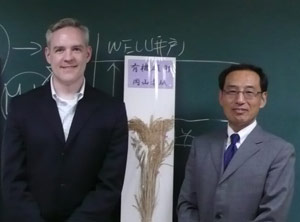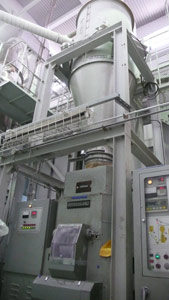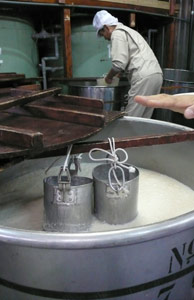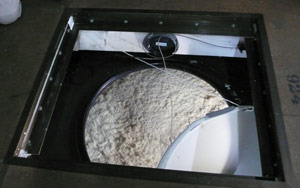Japan 2008: Tamanohikari Brewery

Mr. Ujita, Omachi Rice and me
Today I was the guest of Mr. Hiroshi Ujita, the president of Tamanohikari Sake Brewery, located in the Fushimi district of Kyoto. Tamanohikari is translated as “brilliant jade” What’s in a name? “Tama” signifies the polished gem and the spirit of the sun goddess, and “Hikari” stands for “brilliance and prosperity”. This is a very well known brand in Japan and several of it’s sakes are also widely distributed here in the states.
OmachiYou can’t talk about Tamanohikari without a mention of Omachi sake rice. Omachi is sometimes called the “grandfather” sake rice as it was used in cross breeding a new and very popular strain called Yamada Nishiki. Omachi is not used extensively in a world dominated by Yamada Nishiki, however, the folks at Tamanohikari Brewery have a strong belief in the particular charms of Omachi rice and use it widely in their sakes. Omachi is more difficult to grow than other rices as it grows taller, but dedicated farmers keep the faith and continue to cultivate and Breweries like Tamanohikari continue to make distinctive and delicious sakes from Omachi rice.
Omachi is used in some of the wonderful Tamanohikari sakes that are for sale in the US. I’m thinking particularly of their flagship Tamanohikari Junmai Daiginjo Omachi, a bewitching and elegant, yet grounded junmai daiginjo. Another favorite is the Tamanohikari Yamahai Junmai Ginjo, which pairs beautifully with umami laden dishes and is a foodies best friend. delicious! In addition, the Tamanohikari Tokusen Pack Junmai Ginjo

Rice Milling Machine
Upon my arrival at Tamanokikari Brewery, I was warmly greeted by Mr. Ujita and their master Toji Tsuneo Ueda who both guided me on a tour of the Brewery facility. After we put on our lab coats and hair nets, we marched around the block through the residential neighborhood to the milling facility. Ujita-san showed me the many computer controlled milling machines that run around the clock and process large quantities of milled rice and rice flour every day. I learned a bit how to read the computerized control panel and monitor the target and current milling rate. A marvel of engineering!
After walking back to the main facility, we forged right ahead with the rest of the tour. The Beautiful brewery building was obviously historical, yet alive with activity and fully operational. The beautifully well worn wooden beams supporting the roof expecially caught my attention. One beam was what seemed to be a solid tree trunk. After inspecting the koji room, I got a rare treat as Ujita-san lead me to a magnafying glass to look closely at the koji mold growing on the rice. It was really astounding to see for myself what I’d so often seen in pictures, real hair like strands of mold growing on the rice! (um, You know you’re a sake geek when… you get excited by koji mold)

Carefully Tended Moto
Next, I toured the room where the moto or yeast started was being made. The kurabito or brewery workers obviously lavished a lot of attention on this starter. it’s the genesis of the main mash and rightfully deserves a lot of attention. Tamanohikari uses buckets of ice lowered into the moto to control the temperature which is of utmost importance during the yeast cultivation.
In the brewing facility, I was invited to peer into the sake brewing tanks themselves. Both Ueda-san and Ujita-san explained about watching the bubbles produced by the mash as a way to read the progress of the brewing process. We looked at a tank that had a roaring foam and also a tank that had a few light bubbles each working as a road map of sorts for the Toji, helping him decide on next steps for every batch. The hefty aromas wafting up from the moromi (main mash) were quite startling. Ujita-san encouraged me to really take a big whiff. It smelled of ripe fruit salad with notes of cooked rice and rising bread.

Peering Down into the Brewing Vat
I felt so honored to see the inner workings and living history of such an esteemed sake brewery such as I did today. Taking an in depth look at this one place not only expanded my appreciation for Tamanohikari, but also for Kyoto and for Sake itself. To paraphrase the Grinch, “…In Kyoto they say, his love for sake grew three sizes that day.”
TAMANOHIKARI Sake Brewing Co., Ltd.
545 Higashisakai – Machi Fushimi-ku Kyoto 612-8066 Japan
TEL: 81-75-611-5000 FAX: 81-75-601-0004
www.sake.com



